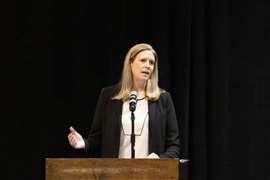Powerscreen's open skies
05 August 2015

Powerscreen used an open day event to introduce the company’s latest crushing and screening equipment to customers and potential customers from the Scandinavian region. Several new machines were on show at the quarry site just outside Stockholm where the machines were put through their paces before the assembled audience over two days.
Flexibility would appear to be an important feature when it comes to mobile crushing and screening equipment according to product manager Oliver Donnelly, who told D&Ri that: “the popularity of specific models is not really dependent on regional demands. We’ve always had certain models, what we call our high volume runners, which are the mid-range machine that are suited to use by contractors, such as the Premiertrak 400, the Warrior 1400 and 1800, and the Chieftain 1700 and 2100X. This is down to the fact that these machines are versatile enough to cover a wide breadth of applications and are well suited to the needs of most contractors, they fit into most transport envelopes below the 50 tonne weight limit.” This interest is now being seen for the company’s larger machines. Regional sales manager Joe Cassidy said: “Some of the contractors are taking on board the larger machines such as the 600, which we will talk about later. These are predominantly for static applications, where they do not have to track very far.” And of course the larger machines also sell direct to end users in mines and quarries.
Nevertheless, market conditions obviously impact on demand but Powerscreen is in a strong position, believes Joe. “Every regional market is faced with certain challenges but Powerscreen historically has had a very strong dealer network and because of this we have a worldwide presence. We will see ups and downs in every market. North America, for example, has remained strong for us as we have a very strong dealer network there with a great route to market, as is the case also in the UK, which has picked up recently. We have various routes to market, whether it is by direct sales to end users in quarries or to contractors, rental or rent to buy, with attractive finance plans. We are working very hard with a number of finance houses to give us attractive rates and effective packages.”
He went on: “Europe remains a challenge, primarily because of the Euro exchange rate against the Pound Sterling, a challenge faced by any Sterling based business, but again we are working very hard with our dealer network. The strength of Powerscreen has always been the ability to work with our dealers.”
“The southern hemisphere is currently going through a bit of a dip. South America, Africa and Australia are a challenge, because the mining industry is undergoing a downturn and in certain regions the construction recycling has not yet taken off, with the latter being a big part of our market.”
Approaching recycling
Powerscreen traditionally came from the mining and quarrying sector and today provides machines in the medium class and upwards, but as Joe said above, recycling applications are increasingly offering an important opportunity. These applications call for machines that are more readily transported, which of course applies to Powerscreen’s medium class machines, as discussed previously by Oliver, but is the company looking at the sector in terms of new product more tailored for these applications?
Oliver responded: “One product we launched at the start of this year was our Warrior 600 two deck tracked screen, which was specifically for the customer base you are talking about, the entry-level type user that wants a machine that can handle a multitude of applications. It is small enough and quiet enough to get the permits required to allow it to work in urban environments. It is a 12 tonne machine, very easily transported and manoeuvred. That’s one example of how we are responding to this demand.”
He went on to say that while there are no concrete plans to produce further machines in this size range, Powerscreen are keeping a close eye on the sector and will in the future likely develop further models in its compact equipment range, possibly by the end of 2016. He was reluctant to give any further details but did say it dovetails quite nicely with the Warrior 600 - something to keep an eye out for.
The reason for this delay in Oliver’s words is “that there are other more pressing areas in terms of product development”. He expanded by saying: “One of the elements that we have been devoting a fair amount of time and effort currently is the development of our telemetry system that we are going to make available on all our machines. Initially, it will appear on our crushers later this year and will be available on our screens in 2016. That is going to be a very powerful tool for us, our customers and our dealers. From a customer’s perspective, if he has a fleet of machines, he will be able to see exactly where each one is at any given moment, what the utilisation rates are, how hard each machine is working. He can also benchmark one machine off against another to allow optimisation of the fleet.”
“There are other important aspects to it in terms of maintenance and preventative maintenance and also from our dealers’ perspective, they will be able to get wear rates on liners and other similar data to allow them to know exactly when a customer requires a new set of wear parts. This will allow them to be in tune with their customers’ needs and ensure that they have the necessary stocks of spare parts,” said Oliver.
Another ‘more pressing’ area saw the introduction of the Premiertrak 600, which Powerscreen has brought to the market in two configurations, a diesel hydraulic machine typical of the rest of its crushing range, and a diesel electric machine with an on-board generator and electric drives. The company has identified a growing demand for electrically driven machines in certain markets, with Scandinavia being a good example for environmental reasons. For a number of years, the company has offered a range of dual power screeners and it has a strong in-house focus on capitalising on what it has done with the 600 to take its electric offering to the next level on its screens, and crushers as well, by moving to full electric drive.
Oliver did say that the company has recently built another prototype that has been out in the field undergoing a substantial level of testing to optimise all the functionality of electric drives, control systems etc. He said: “the results so far have been very impressive and we are very confident that when we do get that machine to market it will dovetail very well with the current product portfolio.”






